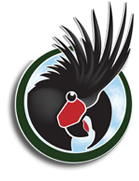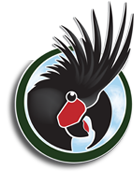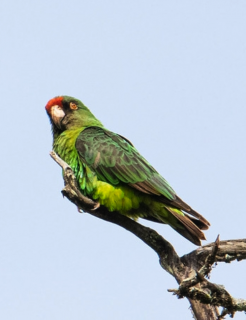Jardine’s Parrot |
|
|
Also known as: Red-fronted Parrot, Red-headed Parrot, Red-crowned Parrot, Congo Red-crowned Parrot
Photos
View in GalleryDid You Know?
The Jardine's Parrot is the only Poicephalus species with scalloped feathering on its body.Academic Research
Related publications: Poicephalus gulielmiSpecies Profile
Genus: Poicephalus | Species: gulielmi
Size:
28cm (10.9 in)
Weight:
200-227g (7-8 oz)
Subspecies including nominate:
three: P.g. gulielmi, P.g. fantiensis, P.g. massaicus
Colour Adult:
P.g. gulielmi: Both adults orange/red forecrown, thighs, bend of wing and carpal edge; dark green head and back with scalloping; upper mandible horn in colour tipped with black, lower mandible dark grey. Cere bare. Eye ring bare and pink/white. Eye orange/red.
P.g. fantiensis: Both adults orange forecrown; paler orange/red thighs, bend of wing, and carpal edge, sometimes orange like forecrown. Smaller in size.
P.g. massaicus: Both adults as in gulielmi but forehead only orange/red.
Colour Juvenile:
P.g. gulielmi: Red on forecrown absent; black frontal band reaching to lores, forecheeks and under eye; pale grey/green bend of wing and carpal edge; green thighs; upper mandible pink/white tipped with grey. Eye brown.
Call:
Calls high-pitched and harsh, made in flight or while perched. Are repeated in quick bursts. Also a longer, whistling note. While feeding quieter whistling sounds emitted. Flocks are loud and contantly babbling.
Listen NowMore Information:
Content Sources:
CITES
BirdLife International
Cornell Lab of Ornithology/Birds of the World
Parrots: A Guide to Parrots of the World, Juniper and Parr, 1998
Parrot and Conure World
ML Media Collection Catalogue 8539, Jardine's Parrot Poicephalus gulielmi, McChesney, Marian, Rift Valley, Kenya, Feb. 23 1956, Cornell Lab of Ornithology. Site
Parrots of the World, Forshaw, 2006. 2010 edition
Parrots in Aviculture, Low, 1992.
Photos
View in GalleryDid You Know?
The Jardine's Parrot is the only Poicephalus species with scalloped feathering on its body.Academic Research
Related publications: Poicephalus gulielmiSpecies Care
Captive Status:
Somewhat common
Longevity:
Up to 30 yrs.
Housing:
Aviary or suspended enclosure, minimum length 3m (9.8 ft).
Diet:
Cooked beans and pulses, boiled corn or maize; dried, soaked or sprouted sunflower seed; fruit such as: apple, orange, pear, banana, pomegranate; vegetables such as: carrot, celery, fresh corn, green beans and peas in the pod; spray millet; complete kibble.
Enrichment:
Are avid chewers so provide bird-safe, unsprayed chew toys such as pine, willow, elder and fir wood and vegetable tanned leather items, branches; puzzle and foraging toys, ladders, swings.
Nest Box Size:
Vertical box 10" x 10" x 20" (25.4cm x 25.4cm x 51cm).
Clutch Size:
3-4
Incubation Time:
28 days
Fledging Age:
10-11 weeks
Hatch Weight:
10g (0.35 oz)
Peak Weight:
Not recorded.
Weaning Weight:
Not recorded.
Photos
View in GalleryDid You Know?
The Jardine's Parrot is the only Poicephalus species with scalloped feathering on its body.Academic Research
Related publications: Poicephalus gulielmiSpecies Wild Status
World Population:
Unknown, decreasing.
IUCN Red List Status:
Least Concern
CITES Listing:
Appendix II
Threat Summary:
Not globally threatened. Rare to fairly common in W Africa; few records in Ivory Coast, although 35 near Maraoué National Park. Present in Kakum and Bia National Parks, Ghana. Uncommon in Korup National Park, Cameroon, fairly rare in Gabon but common in small range, Angola. Uncommon in reserves in Central African Republic. Locally common and widespread in highlands, E Africa; local declines in Kenya likely due to deforestation. International trade for the period 1987–1993 reveals as many as 16,000 birds traded.
Range:
P.g. gulielmi: Congo River basin, from SE Nigeria, S Cameroon, Cabinda and N Angola east to Rwanda and SW Uganda.
P.g. fantiensis: Liberia east to S Ghana.
P.g. massaicus: Highlands of S Kenya and N Tanzania, from Mt. Elgon south to Mt. Meru and Mt. Kilimanjaro.
Habitat:
Found up to 3250m (10,660 ft) in primary montane Juniperus and Podocarpus forest (Kenya and Tanzania). Restricted to lowland rainforest in remainder of range. Also seen in coffee plantations and secondary forest in Angola and Ghana.
Wild Diet:
Feeds on seeds, fruits, flowers and insects, specifically, Spathodea seeds, oil palm Elaeis guineensis nuts, Podocarpus and Cedrus pods, wild olives and seeds of Grevilleas robusta.
Ecology and Behaviour:
Found generally in groups of up to 10 birds but in larger groups where food abundant. Will associate with other birds, such as Rameron Pigeons and Sharpe's Starlings. In some areas, birds will make lengthy trips during the day to forage.
Clutch and Egg Size:
3-4 eggs
Breeding Season:
November-January, Tanzania; September-October, Zaire; March-November, Kenya. Nest is in hollow in living tree.
Related Links:
Photos
View in GalleryDid You Know?
The Jardine's Parrot is the only Poicephalus species with scalloped feathering on its body.Academic Research
Related publications: Poicephalus gulielmiMembers Only Resources
Please log-in now to find more research, resources and tools.
Not a Member?
Find more great information:
Gain exclusive access to 600+ pages of additional research, seminars and podcasts, specialists to ask your toughest questions, and dozens of other fun resources - when you become a WPT member.
Join Today >>

































